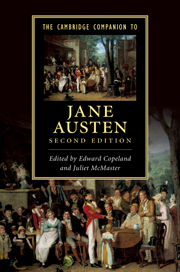Book contents
- Frontmatter
- 1 The Professional Woman Writer
- 2 Northanger Abbey And Sense And Sensibility
- 3 Pride And Prejudice And Mansfield Park
- 4 Emma And Persuasion
- 5 The Early Short Fiction
- 6 ‘Lady Susan’, ‘The Watsons’ And ‘Sanditon’
- 7 The letters
- 8 Class
- 9 Money
- 10 Making a living
- 11 Gender
- 12 Sociability
- 13 Jane Austen and literary traditions
- 14 Jane Austen on screen
- 15 Austen cults and cultures
- 16 Further reading
- Index
- Cambridge Companions to . . .
4 - Emma And Persuasion
Published online by Cambridge University Press: 28 March 2011
- Frontmatter
- 1 The Professional Woman Writer
- 2 Northanger Abbey And Sense And Sensibility
- 3 Pride And Prejudice And Mansfield Park
- 4 Emma And Persuasion
- 5 The Early Short Fiction
- 6 ‘Lady Susan’, ‘The Watsons’ And ‘Sanditon’
- 7 The letters
- 8 Class
- 9 Money
- 10 Making a living
- 11 Gender
- 12 Sociability
- 13 Jane Austen and literary traditions
- 14 Jane Austen on screen
- 15 Austen cults and cultures
- 16 Further reading
- Index
- Cambridge Companions to . . .
Summary
Pride and Prejudice and Mansfield Park operate in opposing aesthetic genres: the first as romantic comedy, the second as anti-romance, or moral tale. What further artistic challenges is Jane Austen setting herself in her next (and last) two novels, Emma and Persuasion? Very different in technique and form – the mature novelist never repeated herself – both novels remain concerned with young women finding their proper place and role in the world of early nineteenth-century England. But there are significant differences in the imagined ‘England’ they evoke, and in the way the two heroines view their world and act in it. Though each novel ends with the heroine’s marriage, their narrative structures are so different as to have the reader searching for new generic descriptors.
Emma
At least two artistic challenges inform Emma. First, it anticipates the detective story in being a novel designed to be reread, with the reader each time discovering more complexities to the hidden story. Second, Austen declared that in this novel she was going to ‘take a heroine whom no one but myself will much like’. No longer lovable, sparkling Elizabeth or ‘my Fanny’, the steadfast heroine; instead, a spoilt, interfering and often deluded young woman, whose energy, good heart and desire to lead need to find their proper outlet. The novelist clearly indicates her position as ironical narrator of this young woman’s story in the opening paragraph:
Emma Woodhouse, handsome, clever and rich, with a comfortable home and happy disposition, seemed to unite some of the best blessings of existence; and had lived nearly twenty-one years in the world with very little to distress or vex her.
(1:1:3)- Type
- Chapter
- Information
- The Cambridge Companion to Jane Austen , pp. 55 - 71Publisher: Cambridge University PressPrint publication year: 2010



